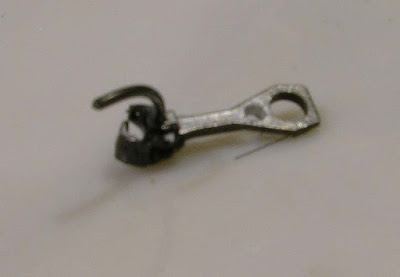For those who have larger radius curves the supplied Trainorama C32 class couplers are too long leaving a large gap between the locomotive and the first carriage.
The supplied coupler is a work of art but there is no way it can be shortened so here is how I managed to do it.
Step 1
I found that there was just enough 'meat' ahead of the pivot hole in a long shank KD 156 coupler to drill a No.50 hole for the C32 coupler pivot screw and file the rear and two sides to match the supplied C32 Trainorama coupler.
To drill the hole I first used a scriber to make a centre mark for the drilling. You will have to mark this by eye as it is too small to try to measure and mark it.
Next I used a No.57 drill in a pin vice to drill the first hole then made it progressively larger with a No.55, No.53, No.52, No.51 and finally No.50 drill. It is best to do it this way as the drill can easily bite into the die cast metal and jam.
Step 2
The next step is to carefully cut the rear hole section of the coupler away. I used a jewellers saw to make the first cut into the hole, this then allowed me to use a pair of sharp transistor wire cutters to snip away the rest. The first cut will allow the metal to be cut away without stressing the drilled area.
Finally I used a fine jewelers file to file the remaining curved section of the original pivot hole at the rear of the new hole away until it just disappeared, this formed the rear face of the coupler.
I then filed the two sides to the same slight angle as the sides of the C32 coupler end, also filing the corners with the same slight curve.
Step 3
I now mounted the coupler.
I managed to lose one of the two small coupler mounting screws and guess which screw isn't in the bag of spares!
I think I may just align it and put a tiny spot of glue on the screw hole if Trainorama can't supply a replacement, hopefully they can.
As you can see by the photo above I still hadn't adjusted the droop of the coupler
I found that I had filed the back just a little too much and as a result the coupler doesn't stay centred but will swing back when pushed sideways, so I suggest you go slowly and try a couple of trial fits until you are happy.
Layout Trials
I have successfully pushed and pulled some 72'6" passenger cars around 30" radius curves, up and down 1 in 40 grades. On the inner side of the curve there was about 1mm between the buffer heads.
Now, to do another for the tender and perhaps have another go at the front one.
Well, that's about it, so have a go, it isn't hard at all.









